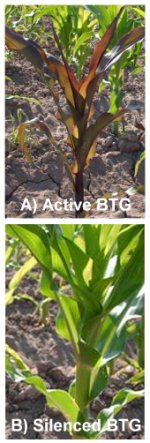Research in the McGinnis Lab
Overview:
Our long term goal is to understand how identical genomic sequences can produce distinct expression patterns and phenotypes. In particular, the lab studies epigenetic regulation of the expression of endogenous and transgenic loci in plants. These phenomena have been shown to be key elements in the growth, development, and gene regulation of a broad range of organisms.
We work predominantly with maize, using a range of molecular biological, genetic, and genomic techniques. In some cases, useful features of other models are exploited, but maize is the superior model for studying these research topics. In addition to maize'ís status as an extremely important crop plant in the United States, the ease of doing genetic experiments in it supports work that would be impossible in other systems. Furthermore, research in maize has made extraordinary contributions in epigenetics, in part as a result of the powerful screening system offered by its well-characterized anthocyanin pathway. Unlike some other model plants, maize shares a similar number of genes, DNA methylation, and overall genome size with mammals, so elucidation of important mechanisms in maize might provide insight into mammalian systems. Interest in these features has grown with our increasing awareness that epigenetic mechanisms are an important component of many human diseases, including cancer, diabetes, and mental illness.
Current research in the McGinnis lab includes the following projects:
Heritable epigenetic regulation of gene expression in maize
 This work originated from experiments using a transgene, BTG, that encodes the B1 protein. This naturally occuring maize protein activates pigment biosynthesis when it is expressed and is an excellent marker for studying epigenetic gene regulation. The transgene can exist in two relatively stable states: silenced and expressed. All vegetative tissues of plants expressing it are dark purple (A). When it is silenced, expression does not occur, and all tissues are green (B).
This work originated from experiments using a transgene, BTG, that encodes the B1 protein. This naturally occuring maize protein activates pigment biosynthesis when it is expressed and is an excellent marker for studying epigenetic gene regulation. The transgene can exist in two relatively stable states: silenced and expressed. All vegetative tissues of plants expressing it are dark purple (A). When it is silenced, expression does not occur, and all tissues are green (B).
Published experiments have demonstrated that the silent BTG is reactivated by three known mutations (McGinnis et al., Genetics 173, 2006), and two of these have recently been shown to be homologous to mutations implicated in RNA-directed DNA methylation in Arabidopsis (Alleman et al., Nature 442, 2006; Hale et al., PLOS Biology 5, 2007). These findings, and the epigenetic changes associated with silencing and activation of the transgene (McGinnis et al., Genetics 173, 2006), strongly suggest that RNA-directed chromatin changes mediate expression of this transgenic locus. The combination of the BTG system and currently available mutants offers a powerful system in which to study the characteristics of heritable epigenetic regulation. We use molecular and genetic approaches to characterize further the mechanisms of epigenetic regulation of BTG expression. These approaches include mutagenesis and screens to identify additional mutants, cloning and mapping of mutants, and detailed characterizations of the mutants. We are also investigating endogenous gene regulation in these mutants to identify native genes in the genome that are regulated by these mechanisms.
Links to individual research projects:
Mapping of the b1 Genomic Transgene within the Maize Genome
Characterization of maize transgene-reactivated mutants
Long non-coding RNA in maize
Nucleosome position and chromatin structure in maize mop1-1 mutants
We have used microarray based approaches to characterize nucleosome position and chromatin structure in maize. This is a collaborative project with the Dennis and Bass Labs at FSU. You can learn more about this project by visiting the project website.







